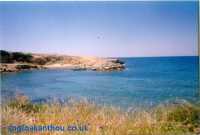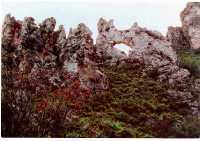|
|
|
||

|
|||

|
|||
|
The locality of Akanthou is a fascinating combination of scenic splendors, as it is displayed by the clear blue expanse of the Sea of Kilikia and the cool ravines and wooded slopes of “ Mavron Oros ” and “ Grousoupi ”, rugged tops of a mountain chain that runs parallel to picturesque, lacy shores. I should particularly like to mention two distinctively beautiful places which can undoubtedly rival the most attractive beauty spots in any country. They are “Thkiatripito” and “Styllarka”. They have been praised by both Nicosia Excursion Association and Famagusta Country Life, two clubs that regularly visited them on their outings. 
“Thkiatripito” in general is a stately rocky giant radiating an aesthetic form of natural grandeur, with a huge hole, four metres across and four in height, opening through the rock of the peak, that enables access from the south side of the mountain to the north. What is more phenomenally astonishing is that before the August full moon rises over the ridge, it appears timidly through this opening to shed its soft light over the magnificent church of “Chrysosotiros” and its vicinity. G Tsellos, president of Nicosia Excursion Association, writes about “Styllarka”.” It is the most singularly beautiful spot that Cyprus has to show, it is really exceptional”. Andreas Ioannou, a teacher, member of Famagusta Country Life Club, writes: “The sight is unique. We take pride in it. I confess that I feel selfishly proud to stand there, facing these strange natural structures”. I was usually invited to accompany excursionists to these rugged places and I should like give you a brief description of “Styllarka”: It is a strange landscape. Situated in a fold of the mountain, there are a number of very tall rocks, more than thirty or forty meters high peculiar in bulk and shape and are mantled by creepers, shrubs, bushes and little cypresses. They rise straight up, standing individually ten to fifteen feet apart, on soft-surfaced ground which is covered with dense forest vegetation: bushes, shrubs and tender, delicate lacy-leaved ferns. These ferns once won first prize at an agricultural show in Famagusta, because the shape of their leaves was regarded as true natural lace unrivaled beauty. 
These two separately located wonderful spots, together with the productive valleys, the olive groves, the narrow strips of cultivated coastal plain planted with carob trees, and the seaside vegetable gardens, make up the area of Akanthou, a typical Cyprus scenery that greatly impresses the visitor. This blessed land of Akanthou has long been cultivated into loose fertile soil by the hard labour of its honest peasants. The beautiful green surroundings, the cool water springs, which happen to be scattered all over the little wild animals and birds, have all had their share in the formation of the gentle, mild temperament of the tireless workers of this land moulding their personalities, to produce the kind, careful, peace-loving folk of Akanthou. I should add at this point that human presence has been established here from time immemorial, and life has gone on, the people enjoying a heritage left by a proud race that once flourished in the neighbouring scattered, now ruined, settlements of Pergamos, Aphrodisium, Alkanthou Komi, Koroni, Mararia and some others the names of which have long been forgotten. These numerous old settlements, found everywhere in Cyprus, are of great significance, being inseparable from other traditional relics. They arouse pleasant thoughts and stirring meditations, because they form our traditional background. There are lots of these remains: Byzantine Castles, country chapels, and the more recent dry-stone walled cottages of “Trika Teratsia”, “Tritos”, “Ayios Charalambos”, “Laxia”, “Kapsalos” and “Kaligrini”. 
It is through all these that our imagination extends over the cities and villages that once prospered on this stretch of land, and in this way this area acquires greater prestige, and the horizon of its character broadens out. Our way of life has always kept us in close constant contact with the ruins of these ancient settlements with their broken marbles, the amphorae and urns, the carved tombs “ with the whitish bones” as Paradiamantis would say, where melodious songs or sad dirges used to be sung by those who have bequeathed us these sacred lands. This is why we have been drawn so close to these ancestors of ours that we do not regard them as strangers, but as old acquaintances, as sacred figures, pure and innocent, whose complaints were not increased by the anodyne activities of any “ Organization of Hierophantic Mission”. These people have imbued us with legends and traditions so much so that we have always lived with intense feelings of adoration for these beloved places. Our land is, therefore, greatly interesting both archeologically and historically. Most of the archeologists who have worked in Cyprus, both foreign visitors and Cypriots, have called at this part of the island. Among them were two celebrated men of the ancient world: Strabo, the historian, and Ptolemy,the geographer. Of the more recent archeologists I should mention Pockoke Drummond (1750), Cesnola (1877), Mas Latrie (1878), Hogarth (1899), George Jeffery (1918) and Gunnis (1929). All these have called in search of the ancient cities, of secondary importance of course, but which played an important role in our national history and greatly helped in the creation of the civilization of Cyprus. 
Historically speaking, the village of Akanthou is mentioned for the first time by its present name in 1383 AD and we are informed that the contemporary Lusignan King James I allocated the village and its lands to the Armenian patrician Sir John Corab, an Armenian citizen. It was customary in those days for the Lusignan Kings, as well as for Crusader chiefs to enter into such alliances with Armenian aristocrats. Mas Latrie mentions that he saw a tombstone in the Armenian cemetery in Nicosia, bearing the name “Maria Corab” and the date 1363. He believed that the tomb belonged to the wife of the Feudal Master of Akanthou. The legend of Akanthou is touching and pathetic. It tells of some marauding pirates who were offered hospitality at a wedding reception at Akanthou, but in spite of that, they decided to kidnap the bride whose name was “Anthousa”. Her father however, managed to hide her in a remote thorny terrain, so the pirates kidnapped the bridegroom instead and carried him off to their ship. Many years passed by. “Anthousa” obstinately refused to go through a second marriage, but in the long run she was persuaded to do so. While the wedding ceremony was taking place, “Anthousa’s” first husband turned up outside the church, riding a horse
.
|
|
|
|

|


